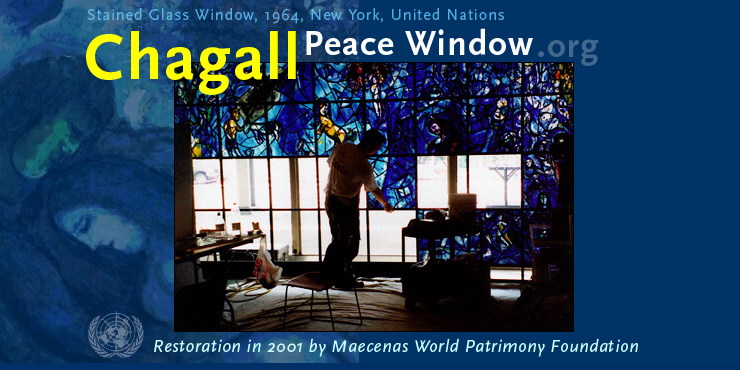| |
|
|
The Restoration
|
| |
 |
| |
The Peace window restoration consisted of:
- Flattening 8 panels
- Re-leading 2 panels. A 'patina' will be applied to the new lead to match the old one.
- Re-putting of 16 panels
- Repairing of broken glass in few panels
- Reconstruction of a lost section of glass
- Retouching of the losses
- Partial removal of old putty on the surface of the glass
The 'Peace' widow, 1964, comprised of 70 sections: 40 large center panels (24 x 25 inches) and 30 smaller border sections.
Structural Support
The sections are within a strong steel frame. The visitors, by having direct access to the window, were able to touch and even lean against it. This resulted in a deflection in two of the sections that had to be re-leaded. One border section was in backwards and was turned around.
Broken Glass
Some pieces of glass were shattered and others had one or two breaks. The broken glass was removed from its lead channel, cleaned with solvent, and was glued. The chipped areas along the break lines were filled and missing vitreous paint was in-painted.
Putty
The linseed-oil putty that provided additional support to the window had dried out. The old putty was removed and replaced with fresh linseed-oil putty. Further, some of the border sections were re-puttied and others were just cleaned. All putty oil was removed from the glass.
The present putty used had a firmer consistency than the original. The technique of application was to thumb the putty under the lead and clean up the surface deposit thoroughly.
Cleaning
The sections that were re-puttied were further cleaned to remove any deposit of putty on the surface. The entire surface on both sides was dusted with a cloth to remove surface dirt.
The restoration project was accomplished in Summer 2001. For this purpose a temporary atelier was situated in the UN Building.
The execution of the restoration work was managed by Fine Arts Conservation Inc. of New York.
|
| |
 |
| |
|
|
|
|
